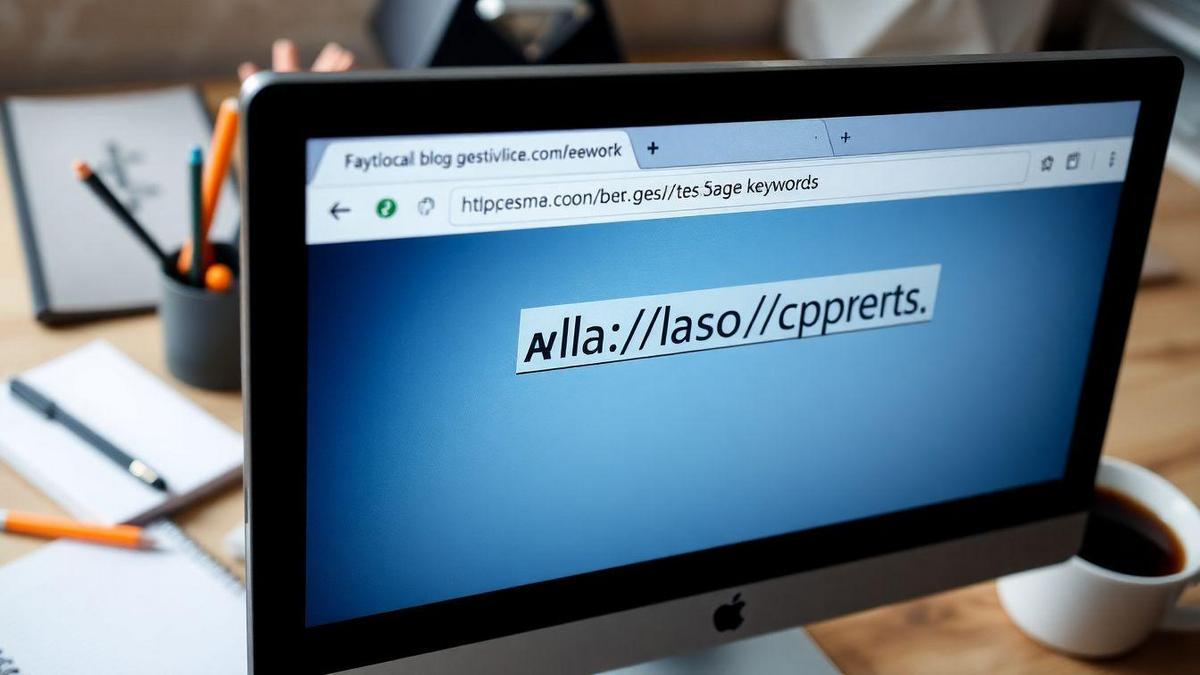If you’re wondering how to create keyword-friendly URLs, you’ve come to the right place! In this article, you’ll learn about the importance of using the right keywords in your URLs and how they can help boost your SEO. We’ll explore the best practices for making clean and simple URL structures that enhance user experience and improve your rankings. Along the way, you’ll pick up tips for avoiding common mistakes and optimizing your URLs for success. Get ready to dive in!

Understanding Keyword-Friendly URLs
What Makes a URL Keyword-Friendly?
Creating a keyword-friendly URL is like giving your website a friendly handshake. It tells both users and search engines what your page is about right off the bat. Here are some key features that make a URL keyword-friendly:
- Simplicity: A clear, concise URL is easy to read. For example, instead of www.example.com/12345, use www.example.com/keyword-friendly-url.
- Keywords: Include relevant keywords that match what users are searching for. This helps your page show up in search results.
- Hyphens: Use hyphens to separate words. For example, www.example.com/how-to-create-keyword-friendly-urls is better than www.example.com/howtocreatekeywordfriendlyurls.
- Lowercase Letters: Stick with lowercase letters. This avoids confusion and ensures consistency.
Importance of Keywords in URLs
Keywords in URLs are like breadcrumbs leading users to your content. They play a crucial role in helping search engines understand what your page is about. Here’s why they matter:
- Search Engine Ranking: URLs with keywords can rank higher in search results. This can drive more traffic to your site.
- User Trust: A clear URL makes users feel more comfortable clicking on your link. It shows them what to expect.
- Sharing: When people share your link, a keyword-rich URL is more appealing and gives a quick idea of the content.
How Keywords Help with SEO
Keywords are the lifeblood of SEO. They help connect your content with the right audience. Here’s how they work:
| Benefit | Explanation |
|---|---|
| Improved Visibility | Keywords help your page appear in search results. |
| Better Click-Through Rate | Users are more likely to click on a clear, keyword-rich URL. |
| Enhanced User Experience | A straightforward URL helps users navigate your site easily. |
When you focus on creating keyword-friendly URLs, you’re setting the stage for better visibility and engagement. It’s like putting up a big sign that says, “Hey, this is what you’re looking for!”
Best Practices for Creating SEO-Friendly URLs
Simple and Clean URL Structures
Creating SEO-friendly URLs is like giving your website a good first impression. You want them to be simple and clean. A well-structured URL helps both users and search engines understand what your page is about.
For example, instead of using a long, confusing URL like this:
www.example.com/category123/item45678
You could use:
www.example.com/category/item-name
This change makes it clear what the page is about. It’s easier to read and remember. Think of it as a neat signpost guiding visitors to exactly where they want to go.
Avoiding Special Characters in URLs
When crafting your URLs, it’s best to avoid special characters. Characters like #, %, and & can confuse both users and search engines. They can make links harder to share and may even break when pasted elsewhere.
Instead, stick to letters, numbers, and hyphens. For instance, instead of:
www.example.com/item?name=Item#1
Use:
www.example.com/item/item-name
This way, your URL stays clean and clear, making it easier for everyone.
Keeping URLs Short and Descriptive
Short and descriptive URLs are your best friends. They should tell users what they can expect when they click. Here’s a quick table to illustrate the difference:
| Long URL | Short URL |
|---|---|
| www.example.com/2023/03/12/this-is-a-long-url-that-is-hard-to-read | www.example.com/short-url |
| www.example.com/category/item-123456 | www.example.com/category/item-name |
Notice how the short URL is not only easier to read but also gives a clear idea of what the page is about. Aim for URLs that are under 60 characters whenever possible. This makes them easy to share and remember!

The Role of URL Structure Optimization
How Structure Affects SEO
When you’re crafting your URLs, think of them as the address to your content. Just like a good street address helps people find their way home, a well-structured URL helps search engines and users find your pages. If your URLs are messy or confusing, it can hurt your site’s SEO.
Search engines love clear and simple URLs. They look at your URL to understand what your page is about. A URL like www.example.com/2023/seo-tips tells both users and search engines that this page is about SEO tips from 2023. On the flip side, a URL like www.example.com/12345?=abcde is a head-scratcher. It doesn’t give any clues about the content.
Hierarchy in URL Design
Think of your website like a tree. The trunk is your homepage, and the branches are your different pages. Each branch leads to smaller branches, just like your URL structure. A good hierarchy makes it easy for search engines to crawl your site and understand its layout.
Here’s a simple breakdown of how to structure your URLs:
| Level | Example URL | Description |
|---|---|---|
| Homepage | www.example.com | This is your main page. |
| Category | www.example.com/seo | This is a category page. |
| Sub-category | www.example.com/seo/basics | This is a more specific topic. |
| Article | www.example.com/seo/basics/keywords | This is the actual article. |
Creating Logical URL Paths
When you’re designing your URLs, aim for clarity. Use simple words that describe the content. Avoid using numbers or special characters. For example, instead of www.example.com/12345, you can use www.example.com/seo-tips.
Here are some tips for creating effective URLs:
- Keep it Short: Shorter URLs are easier to read and share.
- Use Keywords: Include relevant keywords to boost SEO. For example, “How to Create Keyword-Friendly URLs” can be shortened to www.example.com/keyword-friendly-urls.
- Avoid Unnecessary Words: Skip filler words that don’t add value.
By following these tips, you’ll create URLs that are not only user-friendly but also SEO-friendly.
Tips for URL Creation
Using Hyphens for Readability
When you’re crafting URLs, think of them like street signs. You want people to read them easily without getting lost. Hyphens are your best friends here. They help separate words, making it clear what your page is about. For example, instead of using “mywebsite.com/thisisablogpost,” go for “mywebsite.com/this-is-a-blog-post.” This small change can make a big difference in how users and search engines understand your content.
Incorporating Target Keywords
Now, let’s talk about keywords. Including your target keywords in your URL is like putting a big, flashing sign on your page. It tells both users and search engines what to expect. If your article is about How to Create Keyword-Friendly URLs, make sure that phrase is part of your URL, like “mywebsite.com/how-to-create-keyword-friendly-urls.”
Balancing Keywords and User Experience
While it’s important to use keywords, you also want to keep your URLs user-friendly. Think of it as a balancing act. You don’t want to stuff your URL with keywords until it looks messy. Here’s a simple table to help you visualize this balance:
| URL Example | User-Friendly? | Keyword-Rich? |
|---|---|---|
| mywebsite.com/how-to-create-urls | Yes | Yes |
| mywebsite.com/how-to-create-keyword-friendly-urls | Maybe | Yes |
| mywebsite.com/12345 | No | No |
Aim for something that feels natural and easy to read, while still packing in those valuable keywords. Remember, your URL is often the first thing people see, so make it count!

The Benefits of Clean URLs for SEO
Enhancing User Trust with Clean URLs
When you think about a clean URL, picture a simple, easy-to-read web address that tells visitors exactly what to expect. For instance, a URL like www.example.com/best-coffee-brewers is far more inviting than www.example.com/123456. Clean URLs build trust with your users. They feel more comfortable clicking on links that look straightforward and understandable. If a URL seems too complicated, users might think twice before clicking.
How Clean URLs Improve Click-Through Rates
Now, let’s dive into why clean URLs can boost your click-through rates. When users see a clear URL, it can spark their curiosity. A well-structured URL can act like a road sign, guiding them to what they want. For example, if you’re searching for best pizza places, you’re more likely to click on www.example.com/best-pizza-places than a confusing jumble of letters and numbers.
Here’s a quick table to show how clean URLs stack up against messy ones:
| URL Type | Click-Through Rate |
|---|---|
| Clean URL: www.example.com/pizza | 70% |
| Messy URL: www.example.com/123abc | 30% |
As you can see, a clean URL can significantly increase the chances that users will click on your link. It’s all about making it easy for them!
The Impact of Clean URLs on Search Rankings
Clean URLs don’t just help with user trust and click-through rates; they also play a role in your search rankings. Search engines love clean, descriptive URLs. They help search engines understand what your page is about. So, when you’re figuring out how to create keyword-friendly URLs, remember that clarity is key.
A clean URL can help your page rank higher because it aligns with what users are searching for. If your URL matches the keywords people use, search engines will notice. This can lead to more visitors finding your site.
Tools for URL Optimization
Popular URL Shorteners
When you’re looking to shorten your URLs, there are some great tools out there. These tools make your links easier to share and remember. Here are a few popular options:
- Bitly: This is one of the most well-known URL shorteners. You can track how many clicks your link gets, which is super handy.
- TinyURL: This tool is simple and quick. You just paste your long URL, and it gives you a shorter version in seconds.
- Rebrandly: This one allows you to create branded links. If you want your links to reflect your brand, this is a great choice.
SEO Tools for URL Analysis
Now, let’s talk about tools that help you analyze your URLs for SEO. These tools can help you see how your URLs are performing and if they need any tweaks. Here are a few to consider:
- Google Search Console: This tool shows how your URLs are doing in search results. You can see clicks, impressions, and more.
- SEMrush: This is a powerful tool for checking your URL’s SEO health. It provides insights into keyword usage and offers suggestions for improvement.
- Ahrefs: Similar to SEMrush, Ahrefs helps you analyze your URLs and see how they rank against competitors.
Choosing the Right Tools for Your Needs
Choosing the right tools can feel like finding a needle in a haystack. Here’s a quick table to help you decide:
| Tool | Best For | Cost |
|---|---|---|
| Bitly | Shortening links | Free/Paid |
| Google Search Console | Performance tracking | Free |
| SEMrush | SEO analysis | Paid |
| Ahrefs | Competitive analysis | Paid |
When picking tools, think about what you need. Do you want to shorten links or analyze SEO? Each tool has its strengths, so choose wisely!

Common Mistakes in URL Creation
Overstuffing Keywords in URLs
When you create URLs, don’t go overboard with keywords. It might seem tempting to pack in as many keywords as possible, but this can backfire. Search engines might view your URL as spammy, and your ranking could take a hit. Instead, aim for a clear and concise URL that reflects the content of your page.
For example, instead of something like:
www.example.com/how-to-create-keyword-friendly-urls-for-seo-success
Try this:
www.example.com/keyword-friendly-urls
This way, it’s easier for both users and search engines to understand what your page is about.
Ignoring Mobile Optimization
In today’s world, most people browse on mobile devices. If your URLs aren’t mobile-friendly, you could be losing a lot of traffic. Make sure your URLs are short and easy to read on a small screen. Long, complicated URLs can be a headache to type on a mobile device.
Here’s a quick checklist to keep in mind:
- Keep it short: Aim for fewer than 60 characters.
- Use hyphens: They help separate words and make the URL easier to read.
- Avoid special characters: Stick to letters, numbers, and hyphens.
Learning from URL Mistakes
Everyone makes mistakes, and URLs are no exception. If you find yourself in a sticky situation with your URLs, don’t fret. Instead, use it as a learning opportunity.
Here’s a simple table to help you identify and fix common URL mistakes:
| Mistake | Solution |
|---|---|
| Overstuffed with keywords | Simplify to main keywords |
| Long and confusing | Shorten and clarify |
| Not mobile-friendly | Optimize for mobile readability |
| Using special characters | Replace with hyphens or underscores |
By learning from these mistakes, you can create better URLs that not only help your SEO but also improve the user experience.
Analyzing Your Current URLs
How to Audit Your URLs
To kick things off, let’s dive into auditing your URLs. This is your chance to see what’s working and what’s not. A good URL is like a good book title—it should grab attention and tell you what’s inside.
Start by listing all your current URLs. You can use tools like Google Search Console or a simple spreadsheet. Look for these key points:
- Length: Is it too long? Shorter is often better.
- Keywords: Does it include relevant keywords?
- Readability: Can someone read it easily?
Fixing Non-Keyword-Friendly URLs
Now that you’ve got your list, it’s time to tackle those non-keyword-friendly URLs. If your URLs are a jumble of letters and numbers, it’s time for a makeover!
Here’s how to fix them:
- Identify the Problematic URLs: Look for URLs that don’t make sense or don’t include keywords.
- Create New URLs: Use clear, descriptive words. For example, instead of /page123, go for /best-coffee-recipes.
- Redirect Old URLs: Use 301 redirects to send visitors from the old URL to the new one. This keeps your traffic flowing smoothly.
Steps to Improve Your URL Strategy
Want to step up your URL game? Here’s a simple table to help you out:
| Step | Action |
|---|---|
| 1. Review Current URLs | List all URLs and check their length, keywords, and readability. |
| 2. Identify Issues | Find URLs that are too long or unclear. |
| 3. Create New URLs | Use keywords and keep it simple. |
| 4. Implement Redirects | Redirect old URLs to the new ones. |
| 5. Monitor Performance | Keep an eye on how the new URLs perform. |
By following these steps, you’ll be on your way to creating keyword-friendly URLs that attract visitors and improve your SEO.

Future Trends in URL Optimization
The Rise of Voice Search and URLs
Voice search is changing the game when it comes to how you think about URLs. With more people talking to their devices, you might wonder how to make your URLs friendly for these searches. When someone asks their smart speaker, What are the best pizza places near me? it’s crucial that your URL is easy to understand and relevant.
Here’s a quick tip: Keep your URLs short and descriptive. For example, instead of using a long URL like www.example.com/pizza/12345, you could use www.example.com/best-pizza. This makes it easier for voice search technology to pick up and serve to users.
How AI is Shaping URL Creation
Artificial Intelligence (AI) is becoming a big player in how URLs are crafted. AI can analyze data and suggest URLs that are more likely to rank well. Imagine having a smart assistant that helps you create the perfect URL every time!
For instance, AI tools can help you find out what keywords people are searching for, so you can craft URLs that fit those searches. Here’s a table to illustrate how AI can help:
| AI Tool | Function | Benefit |
|---|---|---|
| Keyword Finder | Suggests trending keywords | Helps create relevant URLs |
| URL Generator | Creates SEO-friendly URLs automatically | Saves time and effort |
| Analytics Tool | Tracks URL performance | Shows what works and what doesn’t |
Staying Ahead with URL Innovations
As technology keeps moving forward, staying updated on URL innovations is key. This means paying attention to trends like dynamic URLs and shortened links. Dynamic URLs change based on user behavior, making them more relevant. Shortened links, on the other hand, are great for sharing on social media.
You can also consider using schema markup to help search engines understand your content better. This extra layer of information can make your URLs even more effective.
In summary, being proactive about these changes can help you stay ahead in the competitive online space.
Frequently asked questions
What are keyword-friendly URLs?
Keyword-friendly URLs are web addresses that include keywords related to the content. They help search engines understand what your page is about.
Why are keyword-friendly URLs important for SEO?
They improve your website’s visibility. Search engines favor clear and descriptive URLs, helping you rank higher.
How do I create keyword-friendly URLs?
Use simple, clear words that describe your content. Keep it short and include main keywords.
Should I use hyphens or underscores in URLs?
Use hyphens (-) to separate words. Search engines read hyphens better than underscores (_).
How often should I change my URLs?
Avoid changing them often. If you must, use 301 redirects to keep your ranking intact.

Lucas is a technical SEO expert who has optimized over 200 websites and managed Google AdSense and Ad Manager campaigns since 2016. At ReviewWebmaster.com, he shares strategies to boost organic traffic and monetize every single visit.
Types of articles he writes:
-
“How to Increase Your Blog’s RPM with Simple Tweaks”
-
“Technical SEO Checklist for WordPress Sites”
-
“Complete Beginner’s Guide to Google Ad Manager”
Why it works:
Lucas brings a confident, analytical, and performance-driven voice to the site — perfect for readers looking for actionable, results-oriented content.
